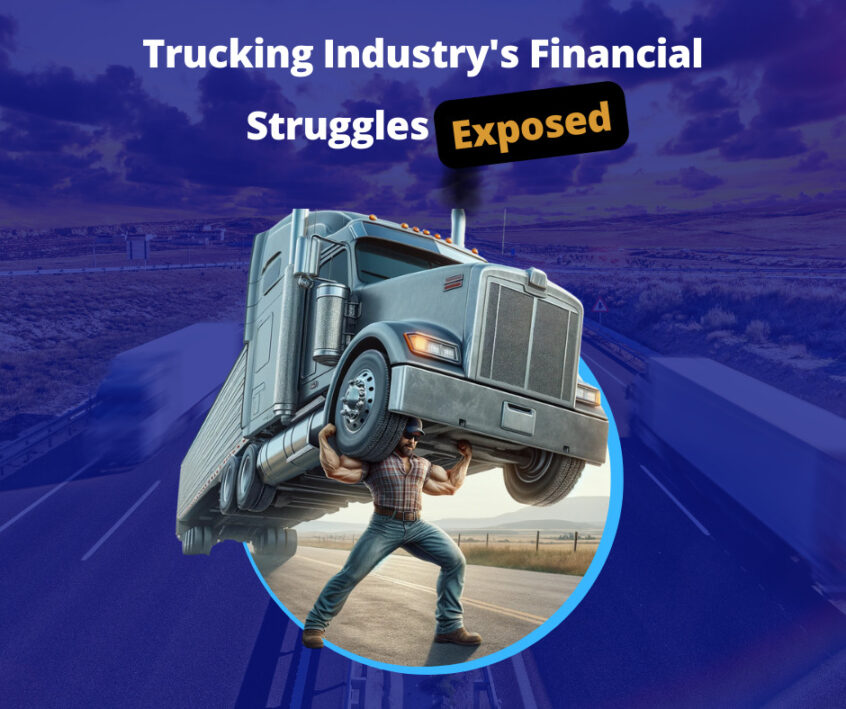
Navigating the paradox of an ailing yet critical sector
As the US economy experiences robust growth (partly driven by increased consumer spending), the trucking industry stands in stark contrast as it grapples with a challenging downturn. The paradox of a booming economy amidst a trucking “bloodbath” raises pertinent questions for the industry and experts. This article delves into the implications of this paradox for the logistics and shipping industries.
Why A Paradox?
The paradox of a booming economy amidst a trucking “bloodbath” can be understood as a perplexing and contradictory situation in which the broader economic landscape appears to thrive. In contrast, the trucking industry faces severe challenges and struggles.
This paradox arises from the apparent disconnect between the strong performance of the US economy and the critical issues plaguing the trucking sector. Let us delve deeper into this paradox by examining its key elements:
1. Economic Prosperity: On one hand, the US economy is experiencing remarkable growth and recovery. Key economic indicators show positive trends, such as GDP expansion and increased consumer spending. This boom is driven by strong job markets, rising wages, and substantial consumer demand for goods.
2. Consumer Spending Surge: An essential component of this economic resurgence is the surge in consumer spending. Americans are purchasing durable goods at a rate that has not been seen in years. This uptick in consumer spending is partly attributed to lower inflation rates, giving consumers more purchasing power. The strong labor market and increased employment also play a role in sustaining this high level of spending.
3. The Trucking “Bloodbath”: In stark contrast to the overall economic growth, the trucking industry faces a dire situation described as a “bloodbath.” This term conveys the severity of the challenges confronting trucking companies, including established carriers and smaller fleets. Truck drivers are struggling due to many factors, including low freight rates, high operating costs, and intense competition.
4. Excess Trucking Capacity: One of the primary reasons for this disparity is the excess capacity in the trucking industry. The period from 2020 to 2021 witnessed an unprecedented surge in the number of trucking authorities. This capacity expansion was fueled by the extraordinary demand for trucking services during the pandemic, such as delivering goods purchased with stimulus checks. However, sustaining such demand levels has proven to be unsustainable.
5. Potential for Industry Restructuring: A significant restructuring of the trucking industry is likely required to address this paradox. This could involve closuring tens of thousands of trucking companies, which would help bring supply and demand back into equilibrium. For many trucking businesses, this means making the difficult decision to shut down operations.
In essence, the paradox of a booming economy amid a trucking “bloodbath” underscores the intricacies of economic dynamics. It serves as a reminder that while the broader economy can experience growth and recovery, specific industries may face unique challenges that require attention and adaptation.
The implications of this paradox are far-reaching, affecting not only trucking companies but also consumers, manufacturers, and the overall supply chain. Addressing this paradox will involve finding solutions that ensure a more balanced and sustainable future for the trucking industry within a vibrant economy.
The Current State of the Trucking Industry
The health of the trucking industry has traditionally mirrored the state of the US economy. However, as of now, this correlation has weakened. While economists marvel at the robust consumer spending and economic growth, trucking companies face dire straits. Consider the case of Matthew James Collins, an Ohio resident and trucker, who highlights the disconnect. His experiences reveal a stark contrast from previous years—moving only 12 skids for two clients compared to 22 skids for four clients.
The trucking industry operates cyclically, with periods of boom and bust. During boom times, manufacturers supply more equipment to trucking fleets, leading to an expansion in capacity and the establishment of new trucking companies. Still, these boom phases are short-lived, as excessive capacity depresses freight rates, and external demand drivers often dwindle.
An Unprecedented Upcycle
The trucking industry’s current turmoil deviates from historical patterns. In an exceptional upcycle that began around June 2020, a surge of trucking authorities was observed. This trend peaked in the summer of 2021 when around 2,000 net trucking authorities were established in a month. This prolonged upcycle defied expectations, lasting twice as long as typical boom phases and creating many new trucking businesses.
Despite this surge, a surplus of trucking authorities persists. In January 2020, there were approximately 255,000 authorities. Today, that number has risen to around 363,000, predominantly consisting of small fleets with fewer than ten drivers. The freight market’s dynamics have been reshaped, posing challenges for established and new trucking companies.
The Struggles of Trucking Companies
The trucking industry’s struggles are underscored by declining per-mile spot rates. Average rates have fallen to $1.54, representing an 11.6% decrease from 2022 and a substantial 34.4% drop from 2021. Simultaneously, the costs of operating a trucking business, including fuel, replacement parts, and insurance, have surged. This has significantly impacted truckers’ earnings.
Many truck drivers, like Brian Carle from New Mexico, are grappling with the harsh reality of scarce and low-paying jobs. Carle’s gross earnings in 2023 are expected to be 33% less than in 2021. The soaring maintenance, fuel, and repairs costs make it increasingly difficult for truckers to sustain their businesses.
Consumer Spending vs. Trucking Industry
The flourishing US economy, led by consumer spending, seems disconnected from the struggles of the trucking industry. The American consumer is driving economic growth by purchasing durable goods, marking the highest surge in spending in nearly two years. However, this upswing in consumer spending has failed to translate into better prospects for trucking companies.
Experts have cited the strong labor market and the persistent demand for consumer goods as reasons behind the continued surge in consumer spending. Nonetheless, the trucking industry remains trapped in a downward spiral, with companies facing financial challenges and job scarcity. As of now, consumers’ penchant for spending is not salvaging the trucking industry. That is a major problem for an industry heavily reliant on consumers’ spending habits.
The Path Forward for the Trucking Industry
The paradox between increased consumer spending and the ongoing “trucking bloodbath” exemplifies the complexities of economic dynamics. The trucking industry’s cyclical nature and an exceptional and extended upcycle have created an oversupply of trucking capacity. This oversaturation and rising operational costs have led to a challenging environment for trucking companies.
The path to recovery for the trucking industry necessitates eliminating excess capacity, potentially resulting in the closure of tens of thousands of trucking businesses. As the US economy thrives on consumer spending, the trucking industry must adapt to these evolving dynamics. It remains to be seen how the trucking sector navigates this challenging terrain and emerges stronger in changing market dynamics.
Wrapping Up
In conclusion, the implications of this situation for the logistics and shipping industries are startling. As the trucking sector adjusts, logistics providers and shipping companies must adapt their strategies to accommodate the evolving landscape. The road ahead is fraught with challenges, but it is one that both the trucking and logistics industries must navigate to thrive in this shifting economic environment.


